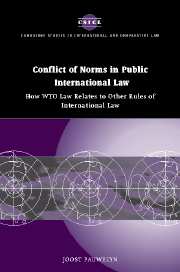 Conflict of Norms in Public International Law
Conflict of Norms in Public International Law Book contents
- Frontmatter
- Contents
- Preface
- Table of cases
- List of abbreviations
- Introduction
- 1 The topic and its importance: conflict of norms in public international law
- 2 The case study: the law of the World Trade Organization
- 3 Hierarchy of sources
- 4 Accumulation and conflict of norms
- 5 Conflict-avoidance techniques
- 6 Resolving ‘inherent normative conflict’
- 7 Resolving ‘conflict in the applicable law’
- 8 Conflict of norms in WTO dispute settlement
- Conclusions
- Bibliography
- Index
- CAMBRIDGE STUDIES IN INTERNATIONAL AND COMPARATIVE LAW
6 - Resolving ‘inherent normative conflict’
Published online by Cambridge University Press: 07 July 2009
- Frontmatter
- Contents
- Preface
- Table of cases
- List of abbreviations
- Introduction
- 1 The topic and its importance: conflict of norms in public international law
- 2 The case study: the law of the World Trade Organization
- 3 Hierarchy of sources
- 4 Accumulation and conflict of norms
- 5 Conflict-avoidance techniques
- 6 Resolving ‘inherent normative conflict’
- 7 Resolving ‘conflict in the applicable law’
- 8 Conflict of norms in WTO dispute settlement
- Conclusions
- Bibliography
- Index
- CAMBRIDGE STUDIES IN INTERNATIONAL AND COMPARATIVE LAW
Summary
Preliminary classifications for conflict resolution
Solutions in the law of treaties, the law of state responsibility and international institutional law
The conflict-avoidance techniques set out in the previous chapter may fail. An apparent conflict then becomes a genuine conflict. Having validly established it as a genuine conflict, resolution of a conflict of norms may involve different disciplines of public international law. The law of treaties, including the provisions of particular treaties, provides the bulk of all conflict rules. Nonetheless, state responsibility is highly relevant. When it comes to acts of international organisations, international institutional law must also be referred to.
‘Inherent normative conflict’ versus ‘conflict in the applicable law’
As pointed out in chapter 4, a conflict of norms may take one of two forms:
One of the two norms constitutes, in and of itself, breach of the other norm. This is what we called an ‘inherent normative conflict’. An inherent normative conflict will arise, for example, when a norm conflicts with another norm of jus cogens or when an inter se agreement is concluded by some parties to a multilateral treaty, in breach of an explicit prohibition to conclude such agreement. We examine the resolution of inherent normative conflicts in this chapter.
Compliance with, or the exercise of rights under, one of the two norms constitutes breach under the other norm. This is what we referred to as ‘conflict in the applicable law’.
- Type
- Chapter
- Information
- Conflict of Norms in Public International LawHow WTO Law Relates to other Rules of International Law, pp. 275 - 326Publisher: Cambridge University PressPrint publication year: 2003
- 1
- Cited by


